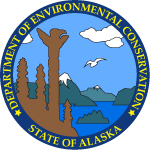| Action Date |
Action |
Description |
DEC Staff |
| 10/14/1991 |
Site Added to Database |
Drilling pad. |
Former Staff |
| 7/15/1992 |
Notice of Violation |
NOV issued due to solid waste violations from June 2, 1974 through May 5, 1992. Over 1400 cubic yards of petroleum hydrocarbon contaminated gravel was identified. |
Simon Mawson |
| 9/29/1992 |
Update or Other Action |
(Old R:Base Action Code = RARR - Remedial Action Report Review (CS)). VECO mixed 1,000 yards of contaminated gravel with 250,000 pounds of cement to make a concrete floor at the equipment shop. An additional 484 cubic yards of contaminated soil was mixed with 169,802 pounds of cement to make a concrete wash rack. The remaining 156 yards of contaminated gravel was mixed with 85,464 pounds of cement to make an equipment refueling containment pad. |
Dennis Timmons |
| 1/6/1995 |
Site Number Identifier Changed |
Old region = 40. |
Scott Rose |
| 4/21/1998 |
Site Ranked Using the AHRM |
Ranking action added now because it was not added when the site was originally ranked. |
Bill Petrik |
| 5/27/2005 |
Update or Other Action |
Received CAP dated March 2005 prepared by Tellus for VECO Alaska, Inc. (VECO) who is current lease holder. |
Linda Nuechterlein |
| 6/2/2005 |
Meeting or Teleconference Held |
Reviewed and provided comments for the March corrective action plan (CAP) for DNR lease lots 23 and 24 located in Deadhorse leased by VECO . Participated in a teleconference with DNR to discuss the CAP and site work which is expected to begin in June 2005. (See email in file for more details.) |
Linda Nuechterlein |
| 6/7/2005 |
Update or Other Action |
Contacted consultant Tellus/Erdman and discussed DEC and DNR comments. |
Linda Nuechterlein |
| 6/9/2005 |
Cleanup Plan Approved |
Corrective Action Plan for Lease tracts 23 & 24 approved by June 9, 2005 letter. Work outlined in this CAP to be completed summer 2005. |
Linda Nuechterlein |
| 12/5/2005 |
Conditional Closure Approved |
Based on information that indicates the contaminant concentrations remaining on site do not pose a risk to human health or the environment, it has been determined that No Further Remedial Action will be required. The RP (VECO) was sent a letter explaining the NFRAP decision on this date.
It should be noted that this conditional closure status applies only to Deadhorse Lease Tract 24, and does not include Tracts 22 and 23 also described as part of the VECO Pad.
Site closure (without conditions) can be achieved when soil sampling confirms that all soil meets the most stringent Method Two migration to groundwater cleanup levels established in 18 AAC 75, Table B2. |
Linda Nuechterlein |
| 12/5/2005 |
Institutional Control Record Established |
Even though information to date indicates the contaminant concentrations do not currently pose a risk to human health or the environment, the NFRAP determination is subject to the following conditions: (1) An institutional control is recorded on the ADEC database to note that there are areas on the pad where hazardous substance contamination may remain above the most stringent ADEC cleanup levels . (2) Any proposal to transport soil off site requires ADEC approval in accordance with 18 AAC 75.325(i).
|
Linda Nuechterlein |
| 7/11/2007 |
Update or Other Action |
Golder Associates called today. They will be conducting a Phase I on the Veco pad, Tracts 22 and 23 next week. PM changed to O'Connell. |
Linda Nuechterlein |
| 2/12/2008 |
Meeting or Teleconference Held |
Meeting today with Elaine Niles of CH2M Hill, formerly VECO. CH2M Hill will be adressing the remaining issues at Tracts 22 and 23 in the coming months, with further characterization potentially occurring in summer 2008. |
Bill O'Connell |
| 5/23/2008 |
Site Characterization Workplan Approved |
Additional site investigation work plan received from VECO/CH2M Hill. Up to 43 soil borings will be advanced across Tracts 22 and 23 in areas of potential concern and up to 2 soil samples will be collected from each borehole. Up to 5 surface water samples will be collected from south and west of the property and analyzed for TAh and TAqH.
|
Bill O'Connell |
| 9/22/2008 |
Cleanup Plan Approved |
Received Corrective Action Work Plan (CAP) for Tracts 22 and 23. Phase II data indicate 4 areas of hydrocarbom contamination that will be addressed under the CAP, C, D, E, and F. Excavation activities will be guided in the field using a PID with confirmation samples collected in accordance with ADEC guidance. Contaminated soil will be transported to AIC for thermal treatment. |
Bill O'Connell |
| 4/1/2009 |
Site Reopened |
Reviewed Phase II assessment report for Tracts 22 and 23. Tract 24 was conditionally closed in 2005. 53 boreholes were advanced at areas of interest and 127 soil samples were collected and analyzed for DRO/RRO, GRO, BTEX, VOCs, PAHs, SVOCs and metals. Surface water samples were collected from 7 locations and analyzed for VOCs and PAHs. Based on sample results, 6 areas of hydrocarbon impacts were identified; Area C (light duty maintenance shop), Area D (Tract 22 Former Fuel Island), Area E (Tract 23 Former Fuel Island), Area F (Tract 22 SW Boundary), Soil Boring Location RSE-10 (North Quonset Hut) and the Fabrication Shop Floor Drain. At Area C, DRO was detected up to 1,610 mg/kg and benzene was detected up to 0.168 mg/kg. At Area D, DRO was detected up to 5,230 mg/kg, GRO up to 1,470 mg/kg and benzene up to 7.28 mg/kg. At Area E, DRO was detected up to 13,700 mg/kg and benzene up to 70 mg/kg. At Area F, hydrocarbon impacted soil from a spill on the neighboring pad had been excavated and treated and treated in 1994. DRO was detected in this area at 887 mg/kg. At boring location RSE-10 near the North Quonset Hut, DRO was detected up to 911 mg/kg. At the Fab Shop Floor Drain, a sample collected below the drain contained DRO at 15,300 mg/kg and benzene at 0.0467 mg/kg. Hydrocarbon impacts were generally present up to 4-6 feet bgs. Surface water samples did not contain detectable concentrations of contaminants. |
Bill O'Connell |
| 4/15/2009 |
Document, Report, or Work plan Review - other |
Reviewed 2008 Tract 22/23 Corrective Actions Interim Letter Report. Excavations were conducted at contaminated areas designated as C, D, E, F, and G. Area C measured approximately 4,629 square feet in area. Contaminated soil volumes were not reported for the various excavations. Confirmation samples collected from the limits of the excavation contained DRO up to 4,040 mg/kg, benzene up to 0.327 mg/kg. Area D measured approximately 18,970 square feet in area. Confirmation samples collected from the limits of the excavation contained DRO up to 3,260 mg/kg and benzene up to 0.320 mg/kg. Area E was not addressed in 2008. Area F was approximately 1,201 square feet in area. Confirmation samples contained DRO up to 9,040 mg/kg, RRO up to 24,700 mg/kg, and benzene up top 0.812 mg/kg. Area G was approximately 2,057 square feet in area. Confirmation samples contained DRO up to 2,270 mg/kg. The report cites potential biogenic interference from the peat sample matrix in some samples; however the specific soil type was not identified for each individual sample. Contaminated soil was transported to AIC for thermal treatment. |
Bill O'Connell |
| 4/30/2009 |
Document, Report, or Work plan Review - other |
Reviewed Corrective Actions Work Plan for Tracts 22 and 23. 2009 work includes the continued excavation of contaminated soil from Area D and the excavation of soil from Area E |
Bill O'Connell |
| 9/1/2010 |
Document, Report, or Work plan Review - other |
Reviewed Former VECO North Slope Lease ADL 64473 Final ADEC Closure Report. The excavation of contaminated soil was conducted at five sub-areas known as Areas C, D, E, F, and G. At Area C on Tract 22, approximately 1,860 in place cubic yards of contaminated soil was excavated from an area 6,500 square feet in size to a depth of approximately 7 feet bgs. Confirmation samples contained DRO up to 16,200 mg/kg adjacent the shop building. At Area D on Tract 22, approximately 9,450 in place cubic yards of contaminated soil was excavated from an area of 44,400 square feet to a depth of approximately 6 feet bgs. Confirmation samples contained DRO up to 3,260 mg/kg. At Area E spanning Tracts 22 and 23, approximately 12,000 in place cubic yards of contaminated soil was excavated from an area of 56,500 square feet to a depth of approximately 6 feet bgs. Confirmation samples contained DRO up to 7,880 mg/kg and benzene up to 26.7 mg/kg, and xylenes up to 118.1 mg/kg. At Area F on Tract 22, approximately 223 in place cubic yards of contaminated soil was excavated from an area of 1,200 square feet to a depth of approximately 5 feet bgs. Confirmation samples contained DRO up to 9,040 mg/kg and RRO up to 24,700 mg/kg. At Area G on Tract 22, approximately 460 in place cubic yards of contaminated soil was excavated from an area of 2,060 square feet to a depth of approximately 6 feet bgs. Confirmation samples contained DRO up to 2,270 mg/kg. A total of approximately 24,000 cubic yards of contaminated soil was successfully treated at AIC in Deadhorse. Generally excavations were limited by the presence of building and utilities, and contaminated soil left in place was left due to the proximity to structures and utilities. Surface water samples were collected from four separate locations adjacent to the pad in 2008 and 2009. Contaminant concentrations in surface water did not exceed Alaska Water Quality Standards for TAH and TAqH. |
Bill O'Connell |
| 9/15/2010 |
Cleanup Complete Determination Issued |
The Alaska Department of Environmental Conservation, Contaminated Sites Program (ADEC) has completed a review of the environmental records associated with VECO Drilling Pad Tracts 22, 23, and 24, located in Deadhorse, Alaska. Based on the information provided to date, it has been determined that the contaminant concentrations remaining on site do not pose an unacceptable risk to human health or the environment and no further remedial action will be required as long as the site is in compliance with established institutional controls (ICs). |
Bill O'Connell |
| 5/10/2012 |
Institutional Control Compliance Review |
IC review conducted, staff changed from O'Connell to IC Unit, five year review added as an IC requirement, and reminder system updated. |
Evonne Reese |
| 8/4/2014 |
Site Reopened |
In July 2014, during demolition of the “dry storage historic batch plant” Quonset hut, contaminated soil was discovered under what was believed to be the support pad for a former boiler. Contaminated soil was also discovered along the north wall of the same building during piling excavation and demolition activities. Letter send on August 5 notifying RP of re-open status. |
Joshua Barsis |
| 8/7/2014 |
Document, Report, or Work plan Review - other |
Approved the work plan for additional characterization via letter. |
Joshua Barsis |
| 10/13/2014 |
Potentially Responsible Party/State Interest Letter |
PRP letter sent on this day. |
Joshua Barsis |
| 1/5/2015 |
Document, Report, or Work plan Review - other |
Reviewed the Site Characterization Report, dated December 8, 2014. Excavation commenced along the north wall of the former batch plant building in late August to remove the in-situ contamination. Roughly 20 cy of POL impacted soil was removed and stockpiled in a lined soil containment cell. Excavation was halted because the extent of contamination was greater than originally anticipated. Several test pits were completed to the north and east of the excavation to delineate the horizontal extent of contamination. Analytical results revealed that DRO is present in the gravel material above the tundra up to 2,400 mg/kg, and in the tundra up to 3,300 mg/kg near the former cement chute building. Soil samples were also collected from the southwest corner of the former historic batch plant building to characterize and delineate the known contamination. Analytical samples collected from this area indicate that DRO and RRO contamination remain in the gravel pad up to 8,400 mg/kg and 28,000 mg/kg, respectively. ADEC requested a work plan by February 15, 2015 to address remaining contamination. |
Joshua Barsis |
| 12/1/2015 |
Document, Report, or Work plan Review - other |
Reviewed the Final Cleanup Report, dated September 14, 2015 for the VECO Drilling Pad, Tracts 22, 23, and 24 site. In August 2015, an excavation commenced to remove impacted soil above ADEC Method Two Arctic Zone cleanup levels from the southwest corner of the former batch plant. Roughly 40 cubic yards of impacted material was excavated and directly transported to OIT in Fairbanks for disposal. Five confirmation soil samples, including one duplicate, were collected from the base and sidewalls of the excavation. Results revealed that diesel range organics (DRO) and residual range organics (RRO) remain in the gravel pad material at concentrations up to 3,700mg/kg and 7,900 mg/kg, respectively. The ADEC Method Two Arctic Zone cleanup levels for DRO and RRO are 12,500 mg/kg and 13,700 mg/kg, respectively. In a letter dated 12-1-2015, ADEC requested a work plan by February 1, 2016 for additional delineation. |
Joshua Barsis |
| 5/3/2016 |
Document, Report, or Work plan Review - other |
Reviewed the Tract 23 Former Batch Plant Area Soil Cleanup Work Plan, dated May 2016. The work plan proposes to collect soil samples, and potentially suprapermafrost groundwater samples from several soil borings advanced at the site. |
Joshua Barsis |
| 1/3/2017 |
Document, Report, or Work plan Review - other |
Reviewed the report titled Follow-on Soil Sampling at the Tract 23 Former Batch Plan, dated for December 2016. Field activities were completed on July 16, 2016 and consisted of collecting soil samples from 13 soil borings advanced at the site. Results from the investigation revealed that the vertical and horizontal extent of contamination has been delineated. Roughly 67 cubic yards of impacted soil above Method One soil cleanup levels remains in the subsurface soils, primarily located near the former northwest cement chute. No soil remains in the pad or tundra material above Method Two soil cleanup levels. |
Joshua Barsis |
| 3/9/2017 |
Document, Report, or Work plan Review - other |
On March 8, 2017 ADEC received a report titled Limited Environmental Site Assessment Southwest Corner North Slope Lease Tract 22, dated August 24, 2016 for the VECO Drilling Pad, Tracts 22, 23, and 24 site. The objective of this effort was to investigate claims of a buried debris field and potential contamination near two Quonset huts on Least Tract 22. Each hut is roughly 100 feet long and 60 feet wide and has a concrete floor. Reportedly, in the early 1980s, various debris including paint, welding rods, sheet metal, and wood were buried near the bollards of the Quonset huts before the concrete floors were installed. Previous uses for the huts may have included painting, sandblasting, steel fabrication, wood working, working with insulated fabrics used to coat piping, and other various manufacturing.
Field activities were completed on July 17, 2016 and consisted of collecting soil samples from 15 soil borings advanced within and outside of each Quonset hut. Each boring was completed to refusal, at depths between to 3.5 and 4 feet below the surface where metal debris, oily waste, or permafrost was encountered. The borings were completed using a hydraulic powered 12-inch auger that was mounted to a small skid steer.
Based on headspace screening results, a total of six soil samples were submitted for laboratory analysis of gasoline range organics (GRO), diesel range organics (DRO), residual range organics (RRO), and volatile organic compounds (VOCs). Soil samples collected from inside the Quonset huts were also analyzed for semi-volatile organic compounds (SVOCs), polychlorinated biphenyls (PCBs), and Resource Conversation and Recovery Act (RCRA) metals.
Results from the investigation revealed that limited petroleum contamination is present beneath the northern Quonset hut (DRO up to 2,400 mg/kg). However, more concerning is the chromium that was present in Sample SB-13 (at 45 mg/kg). Based on information in the report and as recently discussed, ADEC is requested the following to help determine if further action is necessary: (1) Determine the full extent of the debris field. This may be best accomplished using some form of ground penetrating technology; (2) Further characterize the chromium contamination to determine if hexavalent chromium is present; and (3) Further characterize the extent of contamination between this site and nearest surface water body. A work plan was requested by May 1, 2017.
|
Joshua Barsis |
| 7/13/2018 |
Document, Report, or Work plan Review - other |
Reviewed the work plan titled Tract 22 (Quonset Hut Shop Building) Evaluation of Buried Debris and Associated Contamination Work Plan, and dated July 2018. Proposed activities include: evaluating the extent of subsurface debris using ground connectivity and memory earth resistivity meters; determining if chromium is hexavalent or not; and further delineation of petroleum constituents in soil, sediment, and surface water. |
Joshua Barsis |
| 12/14/2018 |
Document, Report, or Work plan Review - other |
Reviewed the December 2018 Tract 22 (Quonset Hut Shop Building) Evaluation of Buried Debris and Associated Contamination Report. Activities completed in 2018 included: mapping of buried debris using an electromagnetic survey and collection of electrical resistivity data to further evaluate subsurface conditions; and collection of soil, sediment and surface water samples as requested, to further delineate the petroleum contamination.
A total of 10 soil samples were collected from 11 soil borings during the 2018 effort. Additionally, collocated sediment and surface water samples were collected from the downgradient surface water body. Concentrations of DRO were identified in one soil sample up to 2,300 mg/kg, however all other samples were either not detected or were below 300 mg/kg for DRO. The sediment sample exhibited levels of DRO and RRO up to 680 mg/kg and 2,300 mg/kg, respectively. All results for the surface water sample were below the more conservative of the Table C groundwater cleanup levels and the Alaska Water Quality Standards. The extent of petroleum-related contamination around the Quonset hut is sufficiently delineated.
As mentioned above, an evaluation of the subsurface was completed using an electromagnetic survey and resistivity data to create subsurface profiles. The text suggests that the extent of the debris is delineated, although it is not inherently clear to ADEC that this is the case based on a review of the figures. ADEC requested a revised report by Feb. 1, 2019. No further action requested at this time. Site should be re-evaluated for closure. |
Joshua Barsis |
| 1/30/2019 |
Document, Report, or Work plan Review - other |
Reviewed the January 2019 Tract 22 (Quonset Hut Shop Building) Evaluation of Buried Debris and Associated Contamination Report. This document is a revised version of the December 2018 report. ADEC is not requesting further evaluation of the subsurface debris. This report is approved.
|
Joshua Barsis |
| 3/12/2024 |
Institutional Control Update |
DNR-SAIL added as affiliate (Office of Primary Responsibility). For DNR LAS information: ADL# 420324 |
Jennifer McGrath |




